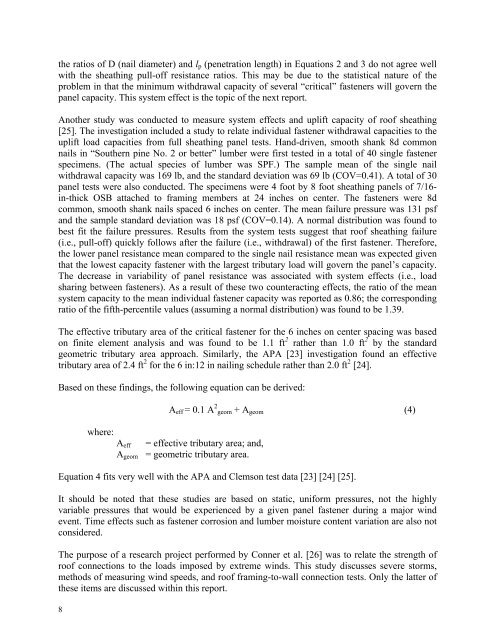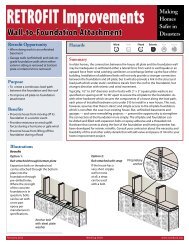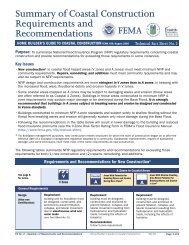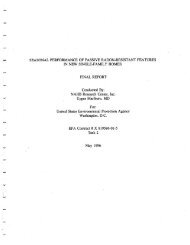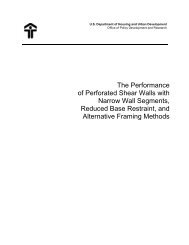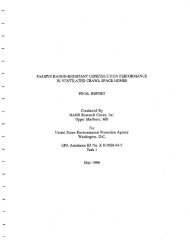roof framing connections in conventional residential construction
roof framing connections in conventional residential construction
roof framing connections in conventional residential construction
Create successful ePaper yourself
Turn your PDF publications into a flip-book with our unique Google optimized e-Paper software.
the ratios of D (nail diameter) and l p (penetration length) <strong>in</strong> Equations 2 and 3 do not agree wellwith the sheath<strong>in</strong>g pull-off resistance ratios. This may be due to the statistical nature of theproblem <strong>in</strong> that the m<strong>in</strong>imum withdrawal capacity of several “critical” fasteners will govern thepanel capacity. This system effect is the topic of the next report.Another study was conducted to measure system effects and uplift capacity of <strong>roof</strong> sheath<strong>in</strong>g[25]. The <strong>in</strong>vestigation <strong>in</strong>cluded a study to relate <strong>in</strong>dividual fastener withdrawal capacities to theuplift load capacities from full sheath<strong>in</strong>g panel tests. Hand-driven, smooth shank 8d commonnails <strong>in</strong> “Southern p<strong>in</strong>e No. 2 or better” lumber were first tested <strong>in</strong> a total of 40 s<strong>in</strong>gle fastenerspecimens. (The actual species of lumber was SPF.) The sample mean of the s<strong>in</strong>gle nailwithdrawal capacity was 169 lb, and the standard deviation was 69 lb (COV=0.41). A total of 30panel tests were also conducted. The specimens were 4 foot by 8 foot sheath<strong>in</strong>g panels of 7/16-<strong>in</strong>-thick OSB attached to <strong>fram<strong>in</strong>g</strong> members at 24 <strong>in</strong>ches on center. The fasteners were 8dcommon, smooth shank nails spaced 6 <strong>in</strong>ches on center. The mean failure pressure was 131 psfand the sample standard deviation was 18 psf (COV=0.14). A normal distribution was found tobest fit the failure pressures. Results from the system tests suggest that <strong>roof</strong> sheath<strong>in</strong>g failure(i.e., pull-off) quickly follows after the failure (i.e., withdrawal) of the first fastener. Therefore,the lower panel resistance mean compared to the s<strong>in</strong>gle nail resistance mean was expected giventhat the lowest capacity fastener with the largest tributary load will govern the panel’s capacity.The decrease <strong>in</strong> variability of panel resistance was associated with system effects (i.e., loadshar<strong>in</strong>g between fasteners). As a result of these two counteract<strong>in</strong>g effects, the ratio of the meansystem capacity to the mean <strong>in</strong>dividual fastener capacity was reported as 0.86; the correspond<strong>in</strong>gratio of the fifth-percentile values (assum<strong>in</strong>g a normal distribution) was found to be 1.39.The effective tributary area of the critical fastener for the 6 <strong>in</strong>ches on center spac<strong>in</strong>g was basedon f<strong>in</strong>ite element analysis and was found to be 1.1 ft 2 rather than 1.0 ft 2 by the standardgeometric tributary area approach. Similarly, the APA [23] <strong>in</strong>vestigation found an effectivetributary area of 2.4 ft 2 for the 6 <strong>in</strong>:12 <strong>in</strong> nail<strong>in</strong>g schedule rather than 2.0 ft 2 [24].Based on these f<strong>in</strong>d<strong>in</strong>gs, the follow<strong>in</strong>g equation can be derived:A eff = 0.1 A 2 geom + A geom (4)where:A eff = effective tributary area; and,A geom = geometric tributary area.Equation 4 fits very well with the APA and Clemson test data [23] [24] [25].It should be noted that these studies are based on static, uniform pressures, not the highlyvariable pressures that would be experienced by a given panel fastener dur<strong>in</strong>g a major w<strong>in</strong>devent. Time effects such as fastener corrosion and lumber moisture content variation are also notconsidered.The purpose of a research project performed by Conner et al. [26] was to relate the strength of<strong>roof</strong> <strong>connections</strong> to the loads imposed by extreme w<strong>in</strong>ds. This study discusses severe storms,methods of measur<strong>in</strong>g w<strong>in</strong>d speeds, and <strong>roof</strong> <strong>fram<strong>in</strong>g</strong>-to-wall connection tests. Only the latter ofthese items are discussed with<strong>in</strong> this report.8


